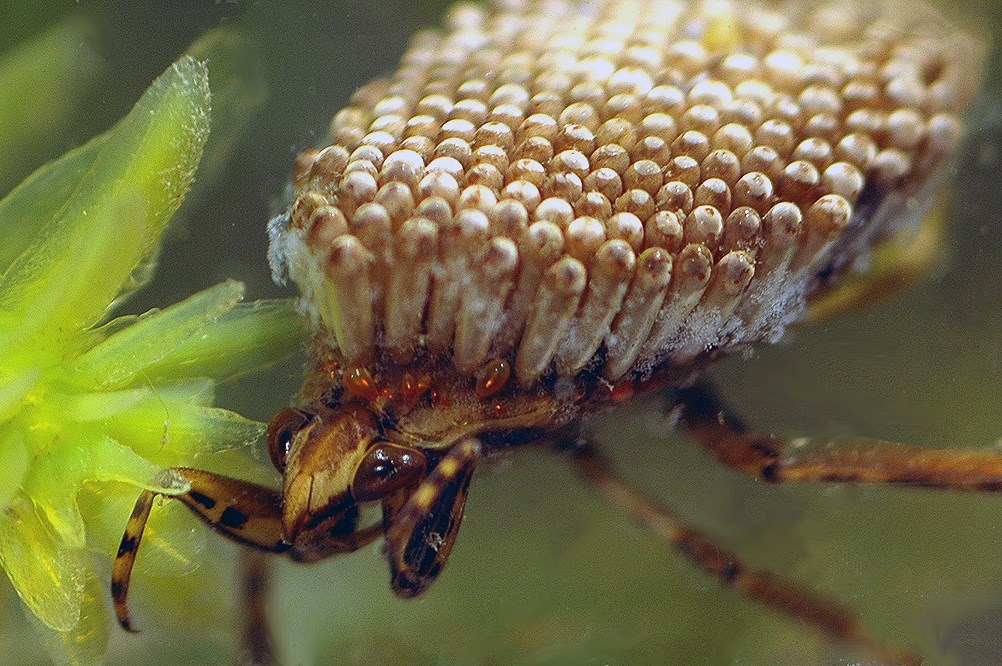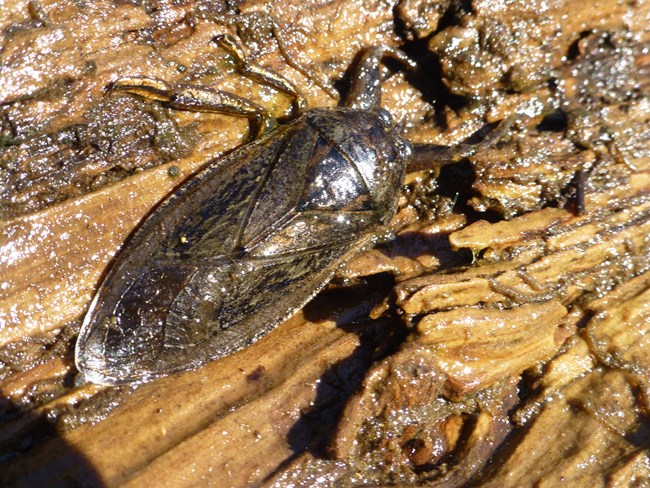Last updated: April 2, 2020
Article
Giant Water Bug

Tom D. Schultz
General Description
When it comes to grisly predators, a giant water bug could hold its own against a hungry polar bear any day. These brown, flattened bugs lurk in freshwater habitat around the world, ambushing their prey and sucking it dry.
Giant water bugs represent the family Belostomatidae, a member of the “true bug” order, Hemiptera. All true bugs have piercing-sucking mouthparts, among other characteristics. The largest species of giant water bug can exceed 12 cm (4.5 in)! Giant water bugs are oval-shaped, with pincer-like front appendages that capture and hold prey. Their rear legs are especially flattened and have tiny hairs (cilia) to help propel them through the water.

NPS
Habitat and Distribution
Giant water bugs live in freshwater ponds, marshes, and slow moving pools in streams worldwide. They are typically hidden in mats of vegetation, just under the surface of the water.
Behavior and Feeding
Giant water bugs prey on a surprising variety of aquatic life, including tadpoles, small fishes, insects, and other arthropods. Some are known to kill prey many times their own size. Grasping victims by “raptorial” front legs, they inject venomous digestive saliva into their prey. This allows them to then suck out the liquefied remains.
How do these bugs breathe underwater? Insects don’t have lungs, like humans, but instead obtain oxygen through tiny holes in the body wall (spiracles) that connect to air-filled tubes called tracheae. Giant water bugs have an appendage on the tip of the abdomen that extends above water to collect oxygen. This is why you’ll sometimes see them tipped at an angle facing downward underwater, with just the rear end at the surface, “breathing.” When the giant water bug dives underwater, it carries air as a bubble under its wings, which can slowly diffuse into its body while it remains submerged.
An unusual trait typical of many giant water bugs is that parental care is reversed—males rear the young. Males in the genus, Belostoma, carry the developing eggs on their back until they hatch. Males of the genus, Lethocerus, guard eggs glued to vegetation until they hatch.
One common name for this bug is “electric light bug,” due to the propensity of some species to fly towards lights at night. Sometimes this lands them in your backyard pool overnight!
Reproduction
In spring and early summer, adults mate and the female lays a batch of 100+ eggs on vegetation or on her male partner’s back, depending on the species. The eggs mature over 1 to 2 weeks and then hatch into nymphs. The nymphs, which look like mini versions of the adult, go through five stages of growth (instars) over the next 2 months before reaching adulthood. Adults overwinter in muddy stream or pool bottoms.
Fun Facts
- Giant water bugs can deliver a painful (though nontoxic) bite between the toes of unsuspecting human feet. This explains one of their common names: toe-biter.
- Giant water bugs can feign death—becoming rigid for several minutes—if removed from the water, only to snap back to life.
- Another defense when disturbed is the giant water bug’s ability to squirt unpleasant smelling fluid from the anus for a few feet.
- One species of giant water bug, Lethocerus indicus, is boiled in saltwater and eaten by people in South and Southeast Asia as a specialty cuisine.
Where to See
While we expect giant water bugs to occur in all Klamath Network parks, our crews have specifically recorded Belostoma bakeri, and Lethocerus sp. during lake sampling in Lassen Volcanic National Park.
More Information
https://blogs.scientificamerican.com/artful-amoeba/the-attack-of-the-giant-water-bug/
https://www.nationalgeographic.com/animals/2019/04/giant-water-bugs-ducklings-snakes-predators/#close
https://thedragonflywoman.com/2012/01/29/abedus-breathing/
Download a pdf of this article.
Prepared by Sonya Daw
NPS Klamath Inventory & Monitoring Network
Southern Oregon University
1250 Siskiyou Blvd
Ashland, OR 97520
Featured Creature Edition: March 2020
Thumbnail image credit: Tom D. Schultz
